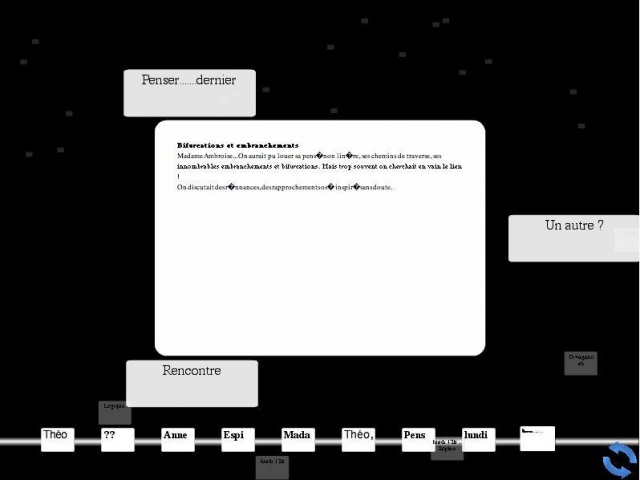Rencontre
IRIS Wiki - IS Systems - Rencontre
Contents
Availability
A web site dedicated to the project is under construction. No public release is available for the moment. Please send an e-mail to Jean-Hugues Réty (jh.rety @ iut.univ-paris8.fr) if you are interested in experimenting the software.
Technical Description
Rencontre is a research project dedicated to interactive narrative with both a theoretical and a practical approach. In this project, a computer model for interactive narrative is defined, as well as authoring and reading softwares based on this model. Authors are also involved in order to experiment and evaluate the tools. The Rencontre software environment is composed of an editor and several readers. The editor is developed in Java and exports XML files (interactive scenarios). Readers can be developed in various programming languages (Java, Flash, etc.). Readers import interactive scenarios as XML files.
When authoring a narrative within Rencontre, an author creates fragments, and groups these fragments into a hierarchy of containers called hypersections (see figure below). A fragment is mainly a content piece that can be displayed to a user. Hypersections can contain fragments, and can also contain other hypersections. Hypersections are structured into a hierarchy (i.e. a tree structure). This hierarchy of hypersections and fragments (fragments are leaves in the tree structure) and their type determine a set of reading paths on fragments.
Result Description (end user perspective)
When a user is reading an interactive narrative authored with Rencontre, he follows one particular reading path. At each reading step (each time the user is reading a fragment), the set of all fragments that can come next is computed (in other words, every fragment that is the next step into at least one reading path is included into this set). The user then interacts with the system: he selects one fragment among this set of fragments. Then the system computes a new set of fragments that can come next, and so on.
Several "readers", software to present the story to the user, have been implemented. One example is shown below.
The Rencontre project primarily focuses on electronic literature and more generally on interactive scenario.
Authoring Description
The author writes fragments and group these fragments in a hierarchy of hypersections. A graphical authoring tool is provided.
Strong Points
This project aims at providing authors intuitive and simple tools for interactive narrrative. Authoring tools are accessible to writers without heavy training and without strong knowledge in video game design. The graphical authoring tool helps the the author manage a large number of fragments.
Readers (software that imports interactive scenarios written with our authoring tool) can propose to the user different modes of interaction with the story, and different ways of visualizing fragments.
Limitations
For the moment, the system focuses on fragment ordering. For instance, constraints on characters, objects or actions cannot be taken into account.
Main Publications
- Réty, J.H., Szilas, N., Clément, J., Bouchardon, S. (2008). Authoring Interactive Narratives with Hypersections. In proc. of ACM International Conference on Digital Interactive Media in Entertainment and Arts, Athens, Greece, september 2008.
- Réty, J.H., Bouchardon, S., Clément, J., Szilas, N. (2008). An experimental tool for digital literature, Elit in Europe conference. Bergen, Norway, septembre 2008.
- Réty, J.H. (2007). Rencontre : un système informatique pour l’écriture et la lecture de récits non déterministes, in actes de H2PTM’07, Collaborer, Echanger, Inventer : Expériences de réseaux, 2007 (in French).
Supporting Narrative Theories
Rencontre is not based on narrative theories like the ones of Greimas or Bremond. The roots of this work are closer to literary hypertext theory (George Landow, Mark Bernstein).
Computational Model
Rencontre is based on the formal description of hypersections. A model is written in XML and it is then used by an execution engine was developed in Java (Réty, Szilas, et al., 2008).
Type of interaction
Interaction depends on the reader software. It can be simple click on words (reader software developed to date implement interaction as « click on words ») but in the future, could become moving a character in a 3D world.

